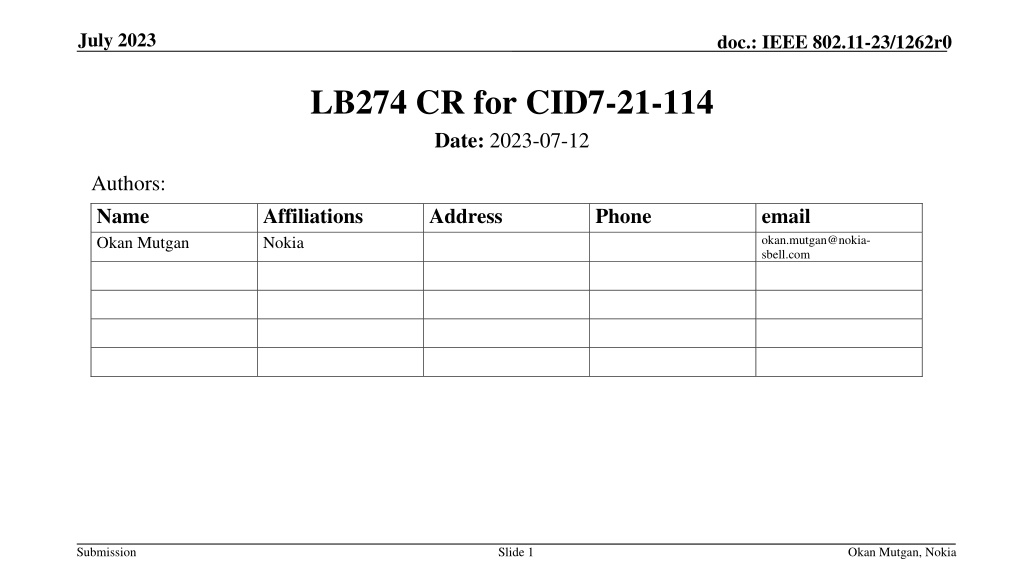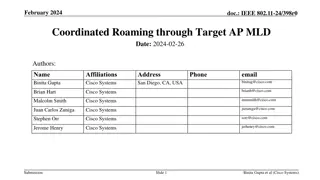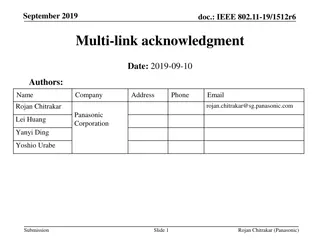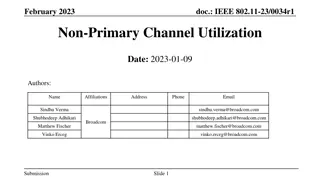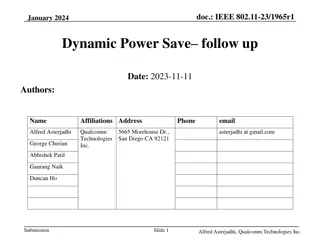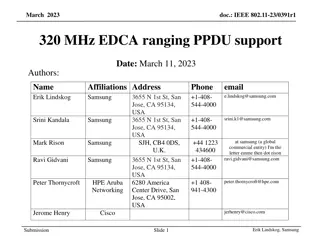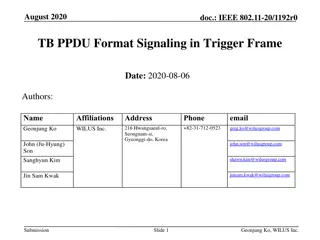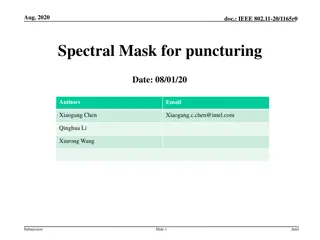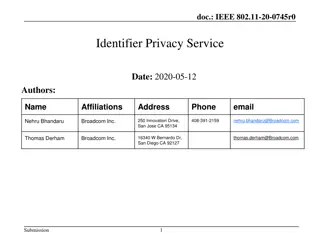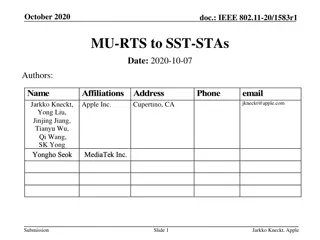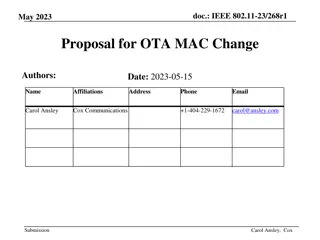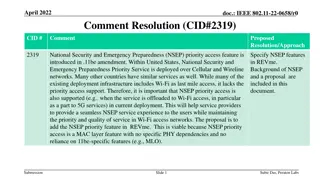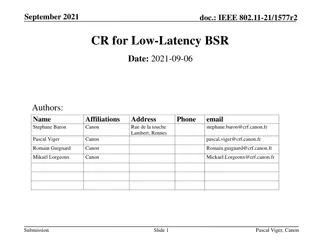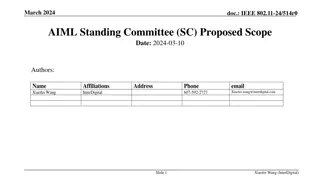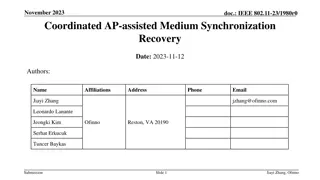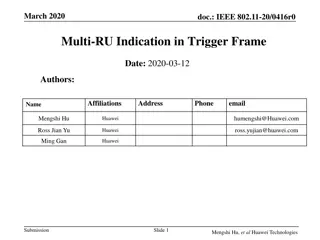Mechanism Proposal to Avoid IRM Conflicts in IEEE 802.11 Networks
This document presents a proposal to tackle IRM collision and conflict issues in IEEE 802.11 networks, particularly focusing on addressing scenarios where multiple non-AP STAs select the same IRM. The document outlines the importance of avoiding IRM conflicts, introduces the concept of IRM Recap, and highlights the need for mechanisms at APs to prevent such conflicts effectively.
Download Presentation

Please find below an Image/Link to download the presentation.
The content on the website is provided AS IS for your information and personal use only. It may not be sold, licensed, or shared on other websites without obtaining consent from the author. Download presentation by click this link. If you encounter any issues during the download, it is possible that the publisher has removed the file from their server.
E N D
Presentation Transcript
July 2023 doc.: IEEE 802.11-23/1262r0 LB274 CR for CID7-21-114 Date: 2023-07-12 Authors: Name Okan Mutgan Affiliations Nokia Address Phone email okan.mutgan@nokia- sbell.com Submission Slide 1 Okan Mutgan, Nokia
July 2023 doc.: IEEE 802.11-23/1262r0 Abstract 802.11bh D1.0 defines IRM solution. Basically, IRM is a non-AP STA generated identifiable MAC Address. There are several CIDs on IRM collision/conflict , that is, more than one STA chooses the same IRM. This document proposes a mechanism to avoid IRM collision/conflict. Submission Slide 2 Okan Mutgan, Nokia
July 2023 doc.: IEEE 802.11-23/1262r0 IRM Recap IRM IE and IRM KDE 0: Not recognized 1: Recognized Submission Slide 3 Okan Mutgan, Nokia
July 2023 doc.: IEEE 802.11-23/1262r0 IRM Recap - For FILS, In initial connection, STA generates IRM and sends (informs) this IRM to AP (ESS) in IRM field of IRM IE in Association Req e.g. IRM1 in next connection(s), STA uses IRM (e.g. IRM1) in Association Req MAC Header (optionally sends IRM IE in Association Req if it wants to use another IRM e.g. IRM2- in another connection) AP sends feedback (recognized/not recognized) to STA in IRM Status Field of IRM IE in Association Resp e.g. recognized Submission Slide 4 Okan Mutgan, Nokia
July 2023 doc.: IEEE 802.11-23/1262r0 IRM Recap - For PASN, In initial connection, STA generates IRM and sends (informs) this IRM to AP (ESS) in IRM field of IRM IE in third PASN frame e.g. IRM1 in next connection(s), STA uses IRM (e.g. IRM1) in first/second/third PASN frame MAC Header (STA optionally sends IRM IE in third PASN frame if it wants to use another IRM e.g. IRM2- in another connection) No Feedback (recognized/not recognized) is defined for PASN Submission Slide 5 Okan Mutgan, Nokia
July 2023 doc.: IEEE 802.11-23/1262r0 IRM Recap - For not FILS or not PASN, In initial connection, STA generates IRM and sends (informs) this IRM to AP (ESS) in IRM field of IRM KDE in 4W HS M4 e.g. IRM1 in next connection(s), STA uses IRM (e.g. IRM1) likely in 4W HS1/2/3 MAC Header AP sends feedback (recognized/not recognized) to STA in IRM Status field of IRM KDE in 4W HS M3 e.g. recognized (STA optionally sends IRM IE in 4W HS M4 if it wants to use another IRM e.g. IRM2- in another connection) Slide 6 Submission Okan Mutgan, Nokia
July 2023 doc.: IEEE 802.11-23/1262r0 What s the problem? As mentioned, more than one STA can choose the same IRM -> IRM collision/conflict CID Commenter Comment Proposed Change 7 Rojan Chitrakar Since the IRM is locally generated at the non-AP STAs, there are chances that two or more non-AP STAs may generate the same address. AP needs to ensure that conflicts are avoided. Add mechanisms at AP to ensure that IRM conflicts are avoided. 21 Jay Yang add the solution to address the IRM collision issue. the colision issue may happened when non-AP STA may allocate a new IRM MAC address to the AP. AP need the deauth the non-AP STA if the non-AP STA allocate a new IRM that is already allocated by another non- AP STA, and it still be valid. And the de-authentication carrying the reason code of IRM collision 114 Okan Mutgan IRM is a (non-AP) STA-generated identifier. There is a possibility that more than one non-AP STA(s) can choose the same IRM, leading to "ID collision". The non-AP STA should know when ID collision happens so that it can choose another IRM. Add a mechanism for IRM to inform non-AP STA about the "ID collision" Submission Slide 7 Okan Mutgan, Nokia
July 2023 doc.: IEEE 802.11-23/1262r0 How to avoid IRM collision? Approach 1: IRM Element defines IRM Status only for not recognized (0) and recognized (1). Also define (2) IRM duplicate. 0: Not recognized 1: Recognized 2: IRM duplicate IRM duplicate shall be signalled from AP after STA generates and sends (informs) the IRM to AP (ESS). This Submission Slide 8 Okan Mutgan, Nokia
July 2023 doc.: IEEE 802.11-23/1262r0 How to avoid IRM collision? Approach 2: Define a reason code in de-authentication/dis-association frame to indicate IRM Duplicate. IRM duplicate shall be signalled from AP after STA generates and sends (informs) the IRM to AP (ESS). Submission Slide 9 Okan Mutgan, Nokia
July 2023 doc.: IEEE 802.11-23/1262r0 Which approach is more suitable? In IRM, STA sends (informs) the IRM to the AP in, - For FILS, Association Request - For PASN, third PASN frame - For not FILS or not PASN, 4-way Handshake Msg4 -> IRM duplicate should be signalled from AP after these frames. Therefore, a reason code with IRM duplicate in de-authentication/dis-association frame would be a better choice (because there is almost no appropriate frame to use IRM status field) When AP sends this reason code to STA, STA realizes that its IRM is duplicate. So, STA generates and comes with another (hopefully not duplicate) IRM. If STA does not know the reason, it might try the same duplicate IRM again and again, and never move on. Submission Slide 10 Okan Mutgan, Nokia
July 2023 doc.: IEEE 802.11-23/1262r0 Further Discussion Some cases to consider: 1 STA A comes in with MAC A and provides IRM B (for next time) STA A goes or stays 2 STA X comes in with MAC X and provides IRM B for next time. That s a duplicate which the AP can recognize. [AP sends to STA: de-authentication/dis-association frame with a reason code = IRM duplicate] [STA comes in with IRM C not a duplicate- and proceeds] 3 STA A comes in with MAC A and provides IRM B (for next time) STA A goes away 4 STA X comes in with MAC B (picked at random or first time IRM associate) AP does not know, thinks it s STA A. Can t see how to recognize that. This case needs further discussion. Submission Slide 11 Okan Mutgan, Nokia
July 2023 doc.: IEEE 802.11-23/1262r0 Straw Poll To avoid IRM collision, I support 1) Approach 1: Using IRM Status field = IRM Duplicate 2) Approach 2: Using de-authentication/dis-association frame with reason code=IRM Duplicate. 3) Neither Submission Slide 12 Okan Mutgan, Nokia
